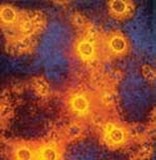IMPORTANT: The Defense Health Agency is aware of the World Health Organization-recommended moratorium on vaccinating boys with HPV vaccine due to increased worldwide demand for this vaccine. However, the manufacturer of the only 9vHPV vaccine used in the United States reports that supply of vaccine in the United States is sufficient for all populations for whom the Advisory Committee on Immunization Practices currently recommends this vaccine. Therefore, DHA recommends that providers continue to follow current ACIP recommendations and offer the 9vHPV vaccine with no restrictions.

Human papillomavirus is a group of more than 150 related viruses. Each virus in this large group is given a number, which is called its HPV type. HPV is named for the warts (papillomas) some HPV types can cause. HPV causes cancers in both men and women, including cancer of the Click to closeCervixThe cervix is the lower, narrow end of the Click to closeuterusAlso known as the womb, the uterus is the female reproductive organ where a baby grows. uterus (womb). The cervix connects the uterus to the vagina (birth canal).cervix, vulva, vagina, penis, or anus. HPV infection can also cause cancer in the back of the throat, including the base of the tongue and tonsils. HPV is transmitted through intimate skin-to-skin contact. You can get HPV by having vaginal, anal, or oral sex with someone who has the virus. It is most commonly spread during vaginal or anal sex. HPV is so common that nearly all men and women get it at some point in their lives. HPV can be passed even when an infected person has no signs or symptoms. You can develop symptoms years after being infected, making it hard to know when you first became infected. Pregnant women can pass HPV onto their babies during birth, although this is not common.
In most cases, HPV goes away on its own and does not cause any health problems. But when HPV does not go away, it can cause health problems like genital warts and cancer.
Genital warts usually appear as a small bump or groups of bumps in the genital area. They can be small or large, raised or flat, or shaped like a cauliflower. A healthcare provider can usually diagnose warts by looking at the genital area.
HPV vaccine is important because it protects against cancer. Every year in the United States, HPV causes more than 34,000 cancers in men and women. HPV vaccination can prevent most of those cancers (about 90%) from occurring. HPV vaccine is recommended for males and females 9 through 45 years of age. All children who are 9 through 14 years old should receive two doses of HPV vaccine 6 to 12 months apart. Adolescents who receive their two doses less than five months apart will require a third dose of HPV vaccine. Anyone who is 15 years of age or older and receiving the vaccine for the first time should receive three doses of the HPV vaccine. The second dose of the vaccine should be received two months after the first dose, and the third dose should be received six months after the initial dose. Three doses are recommended for people 9 through 45 years of age with certain immunocompromising conditions, including HIV. Children and adults aged 9-26 years who did not start or finish the HPV vaccine series should get it now. Adults aged 27-45 years should speak with their provider to see if catch-up vaccination is warranted.
These recommendations apply to all persons, regardless of behavioral or medical risk factors for HPV infection or disease. Women who are pregnant should wait until after delivery to start or continue HPV vaccination.
Source: Centers for Disease Control and Prevention
You will find below all of the resources you will need about the human papillomavirus vaccine. More will be added as they are published or released.
| Manufacturer Package Inserts |
Date |
Gardasil 9
|
April 28, 2023 |